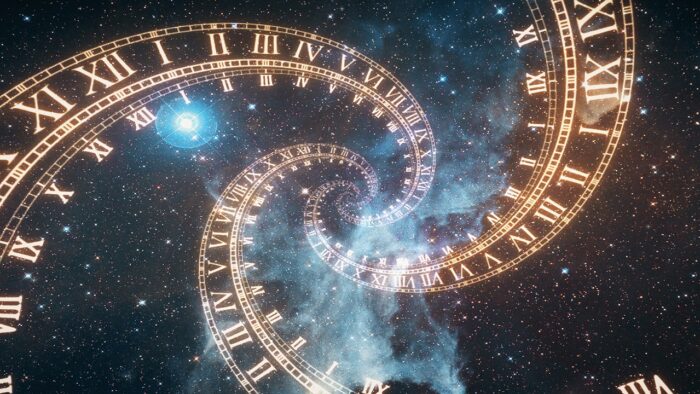The Vedic panchanga is made up of 5 factors viz., the divasa (weekday), nakshatra (moon’s asterism for that day), yoga (angular relationship between the sun and the moon), a tithi (lunar day), and karana (half a tithi). The muhurta (48 minutes timespan) depends on these 5 factors. Further, there are 2 calendar systems viz., Poornimanta and Amavasanta, based on whether the month ends on a full moon or a no-moon day.
For an ancient tithi, different calendar date conversion software programs can calculate the equivalent number of days ‘Before Present’ (BP). This ‘present’ date reference point itself is inaccurate as seen below.
- The ancient Roman, Egyptian, and Coptic calendars
Romulus founded Rome in the 8th century BCE. He used an ancient Roman calendar which had only 10 months in a year. This was one of the earliest calendars known in the western world. The first month of this calendar was March which is why Quintilis (later named July) was the 5th month. Quintilis in Latin means fifth. Similarly, Sixtilis (later named August) was the 6th month, September was the 7th month, October the 8th, November the 9th, and December was the 10th month. Each month consisted of either 30 or 31 days. The year had only 304 days with the remaining days left out as ‘unorganized winter’.[1]
Romulus’ successor Numa formulated the new Roman Republican calendar around the 7th century BCE. He added 2 months January and February to their old calendar. Thus, September was no longer month number 7. But that new Roman Republican calendar used the 19-year intercalary system. Intercalary is an insertion for adjustment of the leap day.[2] Numa also added an entire 13th intercalary month.[3] This 13th month’s insertion was done every 2 or 3 years, or any random number of years as decided by pontiffs.[4]
Meanwhile, the ancient Greeks and Egyptians had their own calendar systems.
Egypt’s new ruler, Greek King Ptolemy III announced the new Coptic calendar through the ‘Decree of Canopus’ of 238 BCE.[5] This Canopic Reform added an extra leap day every 4 years to the Egyptian ‘wandering’ calendar which had 365 days. But this decree did not state which year the correction started. The Coptic calendar had 13 months. Despite the decree, the Egyptians continued using their ancient Egyptian calendar.[6]
Later, there was a rebellion in Hispania in the 2nd century BCE. A Roman Consul had to be sent to crush the rebellion. But the traditional date for appointing a new Roman consul was the Roman New Year date of 15th March. Thus, the start date of the Roman new year was preponed from 15th March to 1st January in 153 BCE.[7] Another account states that the Roman Republic used January and February as the last months of the year till the calendar reform by Julius Caesar in 46 BCE.[8]
The New Year day of the Coptic calendar remained the 1st day in the month of Thoth i.e. the present-day 11 or 12 September.[9]
‘Fasti Antiates Maiores’, the oldest archaeologically attested Roman calendar is dated around 67-55 BCE. This Roman calendar had a 13th intercalary month with 27 days. Their entire year had 8 days in a week.[10]
- Moving from the Roman Republican calendar to the Proleptic Julian calendar
Numa’s Roman Republican calendar was reformed by Julius Caesar in the year 46 BCE. Already, 22 days had been added to that year’s February. Julius Caesar added 3 more intercalary months of 67 days. It is not known why 67 days were chosen. Historians speculate that he may have wanted to align the traditional winter solstice date to 25th December, or there was a new moon day on 1st January 45 BCE.[11]
Caesar dropped the 13th intercalary month in this system. It was decided that the new year from 1st January 45 BCE would have 365 days (like the Coptic calendar). So, 1 or 2 extra days were added to different months. The months were now unequal in duration as Caesar did not want to disturb existing religious ceremonies.[12] Thus, the year 46 BCE had 445 days making it the longest year in western history. It is no wonder that the year 46 BCE is called ‘annus confusionis’, the year of confusion.[13]
Also, the month of Sixtilis was renamed July as Julius Caesar was born in this month.[14]
This new Proleptic Julian calendar started on 1st January 45 BCE. Julius Caesar was killed in 44 BCE. His adopted son Augustus succeeded him and ruled from Rome up to Egypt.
- Moving from the Proleptic Julian calendar to the Julian calendar
The Coptic and Egyptian calendars had many inherent errors. Roman King Augustus ordered a new civil calendar for Egypt in the year 25 BCE through a decree.[15] This newer calendar was called the Alexandrian calendar. A leap day would be added every 4 years and the New Year start date was changed to 29/30 August. It was to be implemented only from 5 CE to catch up with its prior errors.[16]
However, Augustus did not synchronize this Alexandrian calendar in Egypt with the newly introduced Proleptic Julian calendar of 45 BCE.[17] This was because the Proleptic Julian calendar too had developed errors.
To the Proleptic Julian calendar, the Roman pontiffs added a leap day every 3 years, instead of 4 years. They added at least 12 leap days between 1st January 45 BCE to 9 BCE.[18] During the leap years between 45 BCE and 8 BCE, the month of February had 30 days instead of the regular 28 days.[19]
There was so much chaos in this period that over a dozen reputed scholars have each a different ‘Before present’ (BP) date for any given day before 8 BCE.[20] This is very significant to note.
Augustus replaced the erroneous Proleptic Julian calendar with the Julian calendar in the year 4 CE. He decided to add a leap day every 4 years. The leap years stabilized in 8 CE.[21] Also, the month of Sextilis was renamed to August.[22]
Thus, Augustus lived in the confusing era of 4 calendars viz. the Coptic calendar, the Proleptic Julian calendar, the Alexandrian calendar, and the Julian calendar. And the confusion did not end.
- The Gregorian, Proleptic Gregorian and Revised Julian calendars
Romans moved from the 8-day week to 7 days in a week only sometime between the 1st and 5th century CE.[23] Since the exact changeover day or year is not known, we cannot ascertain how many days were removed or added to the year.
Further, some Christians wanted to stop depending on the Jewish calendar every year for deciding the date of Easter. Also, many Christians did not want Easter to coincide with the Jewish Passover day. This controversy of fixing the exact date of Easter started in the 2nd century CE and has continued till today. Different churches continue to follow varied systems even today.
In any case, the Julian calendar was error-prone as it counted the solar year as 365.25 days. But the actual solar year was 365.2422 days. By the year 1570 CE, the Julian calendar was off by 10 days, and hence so was Easter.
The Gregorian calendar was introduced in 1582 CE to primarily reinstate Easter’s association with the Sunday after the 21st March vernal equinox. This was done by advancing the calendar by 10 days from Thursday, 4th October 1582 to be directly followed by Friday, 15th October 1582. Since the sequence of the weekday naming was not changed, the new lunar cycle dates would not align with the old dates. Therefore, scholars state that the Gregorian calendar must be used with great caution for dating events before 1582 CE.
Catholic countries started using the Gregorian calendar in 1582 CE, but Protestant countries in Europe resisted. For example, when Anglican priests told England’s Queen Elizabeth I that the Catholic Pope was the ‘Fourth great beast of Daniel’, she dropped the idea of the new calendar.[24] Britain and its colonies like the USA, adopted the Gregorian calendar only on 14th September 1752 CE by omitting 11 days from their calendar and changing their new year date to 1st January. Since their earlier new year day was 25 March, their year 1751 CE had only 282 days.[25]
Due to this confusion, a Proleptic Gregorian calendar was introduced for all prior events. This is a system of mentioning both the dates for events.
Further, there was a Revised Julian calendar introduced in the year 1923 CE which dropped 13 days from October.[26] Also, 1st January of 1 CE in the Gregorian calendar was 3rd January 1 CE in the Revised Julian calendar. It was done so quietly that very few people in the scientific community know about it even today. If this 2- day shift is not taken into account, it is impossible to implement relevant calendrical calculations using any software.[27]
Today, some Eastern Orthodox Churches follow the Julian calendar, and others follow the Revised Julian calendar. The Catholic and Protestant Churches follow the Gregorian calendar.
- The errors in the Gregorian calendar
The western calendars went from the year 1 BCE directly to 1 CE. The ‘Zero year’ was missing as these calendars used the ‘current year’ system. This was first noticed by German Astronomer J Kepler only in the year 1627 CE. In contrast, Vedic calendars always used the ‘elapsed years’ concept, so there is no ‘Zero year’ error.
Astronomy software tries to take care of this ‘Zero year’ error by giving the years or days ‘Before Present’ (BP). But, the historical practice of counting a year as a leap year using the rule of ‘divisibility by 4’ cannot exist before the ‘Zero year’. This is because a year counted by historians as 585 BCE is actually the year -584. In reality, the years 1, 5, 9, 13… BCE were leap years.[28] But 8 CE is recognized as a leap year, based on which leap years are assigned even today.
Further, the Gregorian calendar skips a leap year every 100 years except if divisible by 400. The Gregorian calendar also does not take care of the differences caused due to the precession of equinoxes and the movement of the perihelion. This gives an error of 1 day every 3,030 years or 4,000 years.[29]
The ambitious Galileo Project calls the Gregorian calendar useless. Many proposed Gregorian calendar system reforms are pending implementation.
Astronomers try to avoid all these confusions by using a Julian Day (JD) number. This Julian Day number counts the number of days elapsed from the start of the Julian Period, assigned as noon 1st January 4713 BCE by Historian JJ Scaliger in 1583 CE.[30] The year 4713 BCE was chosen as it was before any other known historical events of that time.[31]
- Can any present-day software map so much randomness?
The above-noted multiple errors of the western calendars have a cascading effect on a Vedic tithi mapping with the Gregorian calendar. Some sample Gregorian dates are mapped to the Shalivahana shaka samvat date using a few online softwares. The sample dates selected are after 8 CE when a majority of the errors were supposedly solved. But we still can see so many major discrepancies.
 The converse is error-prone in all scenarios.
The converse is error-prone in all scenarios.
For a Vedic event, a date conversion software gives a particular value of X years and Y days ‘Before Present’ (BP) or the elapsed Julian Day (JD). As seen above, the equivalent Julian Days do not match the same tithi by different software. Further, no software can map that ‘Before Present’ date back to a tithi because this reference date itself is incorrect. Also, there are at least half a dozen variations of the ‘Julian Day’ in use today.
Even with simple sampling dates, the present-day astronomy-based date conversion softwares are not accurate. What will happen when we consider 5,125 years BP? Or when a tithi overlaps over 2 divasa? For example, a scripture or an inscription could give a shukla paksha tithi, which could start at 4 pm and end the next day. It is not possible to know the day on which the referred event happened. Similar is the case for adhika maasa. Further, if a scripture or an inscription mentions only a particular krishna paksha tithi, it is virtually impossible to know if it refers to the Poornimanta or Amavasanta calendar system.
We can conclude that for events like the Mahabharata war and the subsequent chronology, we cannot determine the exact ‘Before Present’ date or an exact Gregorian date using any software. The only solution is to rely on our ancient scriptures, inscriptions, Archaeology, Geology and panchanga to date our events.
References:
[1] 5th century CE Roman Historian Macrobius Theodosius’ Saturnalia 12-13 translated by Robert Kaster
[2] ‘The history of Rome Vol I’ by Roberts, Canon et al quote Roman Historian Titus Livius who wrote around 27 BCE
[3] ‘Livius’ A history of Rome’ by Henry G Liddell
[4] ‘Livius’ A history of Rome’ by Daniel Spillan
[5] ‘A commentary on Catullus’ by Robinson Ellis
[6] ‘Canopic Reform’ by Chris Bennett at https://www.instonebrewer.com/TyndaleSites/Egypt/ptolemies/chron/egyptian/chro htm; ‘The Coptic calendar and Church of Alexandria’ by Tadros Malaty
[7] ‘Ab urbe condita 47:13-14’ by Roman Historian Titus Livius
[8] ‘The Roman festivals of the period of the Republic’ by W Warde Fowler
[9] ‘Coptic calendar’ by Gawdat Gabra
[10] ‘Kalendar und Offentichkeit’ by Jorg Rupke; http://www.attalus.org/docs/cil/add_7.html
[11] ‘Handbuch der mathematischen und technischen Chronologie II:123–125’ by German Astronomer and Chronologist Christian Ideler; ‘Dictionaries of Greek and Roman Antiquities’ by William Smith
[12] ‘Saturnalia 1:14:9’ by Macrobius
[13] ‘The lives of the 12 Caesars’ by Suetonius; Richard Amstrong quotes ‘Calendar’ by DE Duncan and ‘Caesar’s calendar’ by D Feeney
[14] ‘Caesar 76:1’ by Suetonius
[15] ‘Ancient Egyptian Science’ by Marshall Clagett
[16] ‘Egyptian Dates’ by Chris Bennett at https://www.instonebrewer.com/TyndaleSites/Egypt/ptolemies/chron/egyptian/chro htm; Theon’s commentary on ‘Handy tables’ by Ptolemy
[17] ‘A brief history of the Patriarchs of the Coptic Church’ by Michael Nabil
[18] Ancient Roman Historical accounts ‘De merabilibus mundi’ by Solinus; ‘Natural History II:18:57’ by Pliny; ‘The Roman History 26:10’ by Ammianus; ‘Life of Julius Caesar 40:1’ by Suetonius; ‘The Natal Day 20:30’ by Censorinus; ‘Saturnalia I:14:13-14’ by Macrobius
[19] ‘De Anni Ratione’ by Johannes de Sacrobosco in 1235 CE
[20] Independent works over a large timespan by different scholars including J Scaliger, C Ideler, H Bunting, P Brind’amour, A Jones, J Kepler, T Harriot, C Bennett, W Soltau, H Matzat, J Christmann, D Hagedorn, E Bickerman
[21] ‘The Oxford companion to the year’ by Blackburn and Holford-Strevens
[22] ‘Augustus 31:2’ by Suetonius; ‘Saturnalia 1:12:35’ by Macrobius
[23] ‘Nundinae’ by James Ker
[24] ‘Popes, astrologers and early modern calendar reform’ by FJ Baumgartner
[25] ‘The Perpetual Calendar’ by Toke Norby
[26] ‘The new calendar of the Eastern churches’ by Miriam Shields quoting M Milankovic
[27] ‘The calendar of the Greek Orthodox Church’ by Dimitrijevic and Theodossiou
[28] ‘Astronomical Algorithms’ by Jean Meeus
[29] ‘Calendars’ by Edward Richards; ‘Outlines of Astronomy’ by John Herschel
[30] ‘Introduction to Positional Astronomy’ by Kenneth Seidelmann
[31] ‘Calendars’ by Edward Richards
Disclaimer: The opinions expressed in this article belong to the author. Indic Today is neither responsible nor liable for the accuracy, completeness, suitability, or validity of any information in the article.









